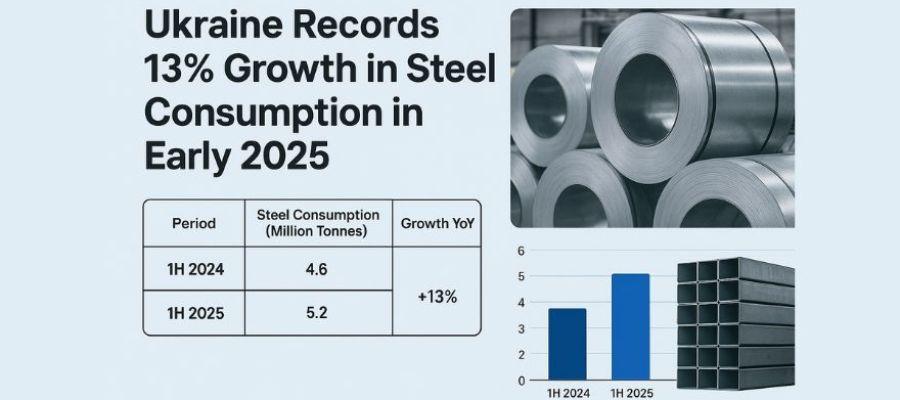The steel industry in Ukraine has shown remarkable resilience in the face of global uncertainties, recording a 13% year-on-year (YoY) increase in steel product consumption during the first half of 2025 (1H 2025). This growth underscores the country’s ability to adapt to economic challenges while continuing its industrial and infrastructure-driven recovery path.
Steel remains one of the most vital materials for Ukraine’s economy, playing a key role in construction, transportation, heavy industry, and exports. The latest figures highlight not only a revival of domestic demand but also a shift in industrial consumption trends that align with broader economic recovery efforts.
Steel Consumption Trends
According to the latest industry data, Ukraine consumed 5.2 million tonnes of steel products in 1H 2025, compared to 4.6 million tonnes in 1H 2024. This represents a solid 13% YoY increase and marks a turning point after years of volatility in the steel sector.
The table below summarises the change in consumption:
Period | Steel Consumption (Million Tonnes) | Growth YoY |
1H 2024 | 4.6 | – |
1H 2025 | 5.2 | +13% |
This upward trajectory is not only a positive indicator for the steel industry but also for Ukraine’s overall industrial health. It suggests an increase in domestic activity across construction, manufacturing, and infrastructure development sectors that rely heavily on steel.
The real volume of consumption rose 9% year over year from January to June as a result of the high level of stocks.
In the first half of 2025, the Ukrainian market's consumption of steel products, aside from polymer-coated rolled goods, stainless steel, and white tin plate, rose 13% year over year to 1.65 million tons. However, the actual rise in market capacity at the end of January-June was almost 9% year-over-year, when the increase in stockpiles at steel traders since the start of the year by more than 120 thousand tons is taken into consideration.
The dynamics of the main segments of long products in the first half of the year were as follows:
- Rebar: The capacity of the rebar market increased by 14% year on year to 355 thousand tons. In 2024, the rebar market experienced a change in demand toward residential development, mostly in western Ukraine, as opposed to numerous infrastructure and fortification projects. The fall in sales was partly caused by the termination of the USAID initiative, which funded the construction of shelters over power plants.
- Wire rod: The market for wire rod dropped 5% year over year to 230 thousand tons. Among other reasons, the use of various non-metallic replacement products contributed to the decline in demand for wire rod for defence fortifications. Growth in hardware product export sales helped offset the market drop in the reinforcing category.
- Shaped rolled products: The market of shaped rolled products (beams, angles, channels) grew by 12% YoY, up to 99 thousand tons.
- Grinding balls: The market of grinding balls decreased by 8% y/y, to 56 thousand tons. Lower iron ore export supplies affected the utilisation of mining and processing plants and, accordingly, the decrease in demand for balls.
- Rails: The rail market grew by 4% y/y, to 22 thousand tons.
- Other long products: The market of other long products (round, strip, square) grew by 4% y/y, up to 77 thousand tons.
- Welded pipes: The UHW profile market continued to stagnate and declined by 23% y/y, to 10 thousand tons. This was due to the curtailment of operations at mines in the war zone, primarily in Pokrovsk.
Flat-rolled products showed the following growth dynamics in the first half of the year:
- hot-rolled steel – by 13% y/y, to 487 thousand tons;
- cold-rolled steel – by 5% y/y, to 145 thousand tons;
- galvanised steel – by 37% y/y, to 199 thousand tons, which significantly exceeds the growth dynamics of other segments of the flat rolled products market
The large rise of galvanised rolled products was driven by significant imports by key players against the backdrop of predicted market segment activation, as well as the expansion of local polymer-coated rolling product manufacturing.
Implications for the Steel Market
The 13% increase in steel consumption is a promising signal for both domestic and international stakeholders. For local producers, the rise means greater market opportunities and capacity utilisation. For foreign investors and trade partners, Ukraine’s steel sector is proving to be a reliable and growing market in Eastern Europe.
Additionally, the steel industry’s performance has broader implications for Ukraine’s GDP growth. A strong steel sector not only strengthens exports but also supports allied industries such as logistics, construction, and heavy machinery.
Future Outlook
Looking ahead to the rest of 2025, Ukraine’s steel consumption is expected to maintain an upward trend. If reconstruction projects continue at the same pace and manufacturing output expands further, steel demand may even surpass forecasts.
However, certain challenges remain, including global price fluctuations, supply chain constraints, and energy costs that could affect production. Despite these risks, the industry outlook remains optimistic, given the current growth momentum.
Conclusion
The 13% YoY increase in steel consumption during the first half of 2025 highlights the resilience and growth potential of Ukraine’s steel industry. Backed by infrastructure investments, manufacturing growth, and rising export opportunities, the sector is on a strong recovery path.
As Ukraine continues to rebuild and strengthen its industrial capabilities, the steel market will remain a cornerstone of economic progress, ensuring the country’s position as a key player in the regional steel trade.
For updates and additional information, follow on social media platforms.
Social Media: LinkedIn, Instagram, Facebook, Pinterest.

